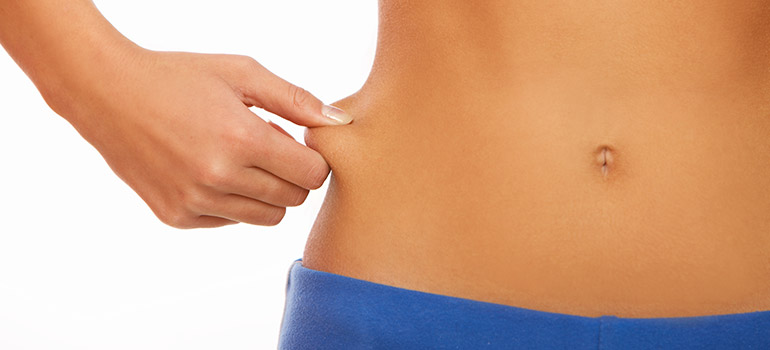We hear all the time about obtaining ideal body fat percentages, but what is considered ideal? And how do you even measure body fat?

What woman doesn’t love to talk about her body fat?
Yeah, no one.
If you want to see how fast I can change the subject, ask me about my body fat percentage. Unless my husband asks me about it, then he gets to witness how quickly I can go from a Disney princess to a Disney villain. Let’s just say he’s learned not to ask such a silly question.
Yet, like it or not, measuring body fat has gained popularity in the last few years. It used to be that the mention of body fat percentage used to refer to an athlete or a bodybuilder. Now, it applies to all of us.
Along with the rise in American obesity rates and the realization that BMI isn’t exactly accurate, measuring body fat became more prevalent. Why? Because it is a more reliable determinant of how much actual fat our body is carrying.
Also due to the rise in body fat measurements, we also now commonly hear, and probably more often than we’d like, phrases such as “ideal body fat percent” and “ideal for your body type.”
First of all, who is deciding what is “ideal” and what do they mean by “body type”? Are they implying that there’s something wrong with the body I’ve got? Am I supposed to have a particular body type?
Just what we all needed, more doubt surrounding our body image.
I believe the time has come to get some clarity. Because in reality, knowing your body fat percentage is very advantageous to your health and well being. Having a lower body fat percentage can help prevent us from developing diabetes, heart disease, etc.
There are essential body fat charts full of numbers that will tell us where on the spectrum we fall. But this is not about what will make you ideal because you’re already ideal just as you are. Instead, we will look at measuring body fat percentage to help us be healthier, stronger women. Simple as that.
Before we start, you need to know that no matter what any chart may say, what you see in the mirror every day is already “ideal” and numbers don’t always give the full story.
Now, let’s figure out this body fat percentage business together, shall we?
Understanding Essential vs. Non-Essential Body Fat

In case you did not know, our bodies need a certain amount of fat to function. So despite all the best efforts of fat-free diets that have dominated our culture since the 1980s, we need fat.
That necessary fat is what is known as the essential body fat. It helps support cell growth, protects our organs, and helps keep our body warm. The essential body fat ranges are different for men and women, where men require only 3%, and women require around 13%.
Before you begin declaring that it’s unfair that women have to have more fat than men, let’s first discuss why! Studies show that estrogen reduces a woman’s ability to burn energy after eating, resulting in more fat stored around the body.
So, is there a reason for our bodies to store more fat than men’s bodies, or is it just a design flaw? Nope, there is no design flaw, there is actually a fundamental reason—the female body stores fat as a natural response to keeping our bodies primed for childbearing.
Where we tend to run into trouble with fat is with the non-essential body fat. Through the 1970s and 80s and on into today, the total body fat that Americans carried is steadily on the rise. With that rise came an increase in health issues such as heart disease, diabetes, and more.

The aforementioned fat-free diets that gained popularity in the 1980s were part of the belief that if Americans are getting fatter, then it must be fat we need to cut from our diet. The trouble was, a lot of the fat-free diets did not encourage us to lose body fat safely.
Another problem with the fat-free diets is that they were just targeting one factor: fat. However, the stored fat in our body comes not only from eating fat but also from carbs, sugar, protein, basically too much of anything! Our body creates fat due to a continuous caloric surplus. It is a tried and true fact that when we eat more calories than we burn, our body will store it as excess body fat. Simple as that.
Therefore, reducing body fat becomes less about looking good and more about feeling good and living a longer, healthier life.
Now, let’s dive into body fat ranges, figure out what is considered high or low body fat, and learn the ways to calculate body fat.
Ideal Body Fat Ranges

A fun fact about body fat percentile ranges is that they increase with age. Since older individuals tend to store body fat more due to aging, the range of what is considered healthy body fat increases.
However, having a higher body fat percentage as we age does not equate to being overweight or obese. The range on the body fat percent chart is adjusted with age to consider what is healthy, at the different points in our life.
For example, here are the ideal body fat ranges for women of different ages:
18-20 years old: 19.7-21.5%
21-25 years old: 20.3-22.1%
26-30 years old: 22.2-24.5%
31-35 years old: 23.4-25.1%
36-40 years old: 24-25.7%
41-45 years old: 24.6-26.3%
46-50 years old: 25.2-28.6%
50-55 years old: 27.6-29.2%
56 & up: 28.2-29.9%
Important Considerations When Determining Your Ideal Body Fat Range
There are a variety of ways women have been describing their bodies for years.
Pear-shaped, apple-shaped, hourglass…
The list goes on.
But regardless of your shape and how you describe it, every body is beautiful. That we each have our own unique shape is one of the great things about the female body. Some of us carry more body fat below the waist, known as lower body density. Some of us carry more above the waist, aka upper body density, while others may have body fat distributed throughout.
We have the women in our family who came before us to thank for our shape, as our unique curves are hereditary. Body type heredity can determine if we are more pear-shaped, apple-shaped, or hourglassed. So when you are looking at body fat percentage, consider your body type as well.
Measuring Body Fat

OK, now we know what is considered the ideal body fat percentage, but how do you measure body fat?
Well, you certainly can’t step on a bathroom scale and determine it because your traditional bathroom scale measures everything. And by everything I mean: fat, water retention, muscle mass, urine, bones, organs, clothes, your cell phone in your pocket, everything! For that matter, your bathroom scale is not a good determinant of any kind when it comes to monitoring weight loss.
While yes, some modern bathroom scales do claim to have the ability to measure body composition, there is still a wide margin of error. You want to get as accurate a number as possible when measuring your body fat. That is why finding a proper body fat calculator is essential.
In the twenty-first century, you do not need to use a machine that will estimate body fat. There are now various options available for measuring body fat more accurately. There are also popular methods still used today that are outdated. I will dive into both the new and the outdated so you know what to look out for.
A quick note of measuring body fat mass before we proceed. Measuring body fat is not something you do every day or even every week. At the maximum, you should measure your body fat once every two weeks, if not once a month. It takes the body time to burn and shed its stored body fat, so patience is vital. If you measure too often, you will see fluctuations that may discourage you.
To put it simply: Trust your body, and let it do its thing.
BMI (Body Mass Index)

First, let’s talk about the most common method for measuring body composition: BMI or Body Mass Index.
Though BMI is outdated, it is still popular today to determine if someone is underweight, healthy, overweight, or obese. BMI is calculated by considering your weight in pounds multiplied by 703 and then divided by your height in inches. The formula would look something like this
Weight (lbs) x 703 ÷ height (inches) = BMI
Like body fat percentage, BMI is also based on your age. So once your BMI is calculated, it is then compared to the ideal range for your age.
While BMI is inexpensive, it is also extremely inaccurate because its measurements are so broad. Using the BMI formula above, a twenty-something female Olympic athlete who is 5’10” with 15% body fat could possibly fall into the overweight or obese category on account of her muscle mass weighing more as compared to her height and age.
That is why I discourage using BMI as any form of accurate measurement regarding body fat or body composition. There are far more accurate options out there.
Skinfold Calipers
Skinfold calipers were developed in the 1970s and are still popular today as an inexpensive method for measuring body fat. However, while some professionals still use this method as a quick reference for body composition, it has a higher risk of inaccuracy.
The procedure involves measuring the thickness of the skin’s folds at various points around the body, such as the waist, thighs, arms, etc. While you can gain a certain perception of body composition from skinfold calipers, the risk of error can outweigh it.
For starters, if you are going to use skin calipers, a professional should measure it, and that same professional should be who measures it each time. If different professionals perform the measurements, you run the risk of getting inaccurate readings each time. One professional may possibly measure a different part of your thigh or hips than the professional before. When you don’t measure the same spot on your body each time, you do not get a clear understanding of your actual progress.
The other issue with skin calipers is when you measure. For example, if you measure while menstruating, when women tend to retain water, and then another when you aren’t menstruating, your measurements can be affected.
So again, while skin calipers may offer some insight into body composition and progress you might be making, remember that it has a high margin for error.
Handheld Body Fat Monitor

Have you ever walked into a gym and seen someone holding something out in front of them that resembles a video game console controller? If you have, then you have most likely seen someone using a handheld body fat monitor.
Handheld body fat monitors use bioelectrical impedance analysis (BIA) to measure your body fat. BIA is a weak electric current flow sent through the body to measure and calculate fat vs. muscle composition.
Handheld monitors are more commonly used today by personal trainers and other professionals. For one thing, they have a lower possibility of error. Secondly, handheld monitors are quick, efficient, and economical in cost compared to higher-end body scanners.
Another perk to handheld monitors is that you can buy one for yourself to use at home. They are relatively simple to operate and you can get one of good quality for about $100-$300.
If you are a gym member, you can typically ask to get a boy fat reading with a handheld monitor. Usually, they are happy to assist in doing so. Just note that some gyms may charge a small fee for the reading.
Others Methods of Measuring Body Fat
Other methods for measuring body fat more accurately have come onto the market in the last ten years. While many of these methods may provide you with the most detailed information regarding your body composition, they can also be costly.
Nevertheless, I want to share a few of the most popular of those methods with you. After all, you never know when you might get the opportunity to try one.
- Dual-Energy X-ray Absorptiometry (DXA): One of the most accurate ways of measuring body composition, a DXA scan (also known as a DEXA scan), is a 10-minute body fat test that takes a comprehensive snapshot of your exact breakdown of bone, fat tissue, and muscle mass.
- Bioimpedance Spectroscopy (BIS): BIS is a method for measuring body composition based on the rate at which an electrical current travels through the body. Body fat causes higher resistance than fat-free mass and slows the rate at which the current travels. But don’t worry, you don’t feel anything even though an electrical current is sent through your body.
- Air Displacement Plethysmography (Bod Pod): BOD POD measures body composition using whole-body densitometry. The physics behind the measurements is related to Archimedes’ Principle regarding buoyancy’s physical law, with the calculation using air displacement to obtain measurements.
- Hydrostatic Weighing: Possibly the most unique way of measuring body composition, hydrostatic weighing is also one of the most accurate ways to measure body fat. As opposed to air displacement, hydro (or water) displacement is used. You’ll be submerged in water while you sit on a scale and an administrator will calculate your body fat percentage by comparing your land weight with your underwater weight. This method is also related to the Archimedes’ Principle of buoyancy.
- 3D Body Scanners: What this does is all in the title. A 3D scanner takes several two-dimensional or three-dimensional depth maps of the body. It uses these images to create a 3D avatar of your body, which then extracts various metrics, such as body fat and circumferences.
- Multi-Compartment Models: Multi-component body composition models are a class of inference models that use more than one source of measurement data to achieve a more valid estimate of body composition. While multi-compartment models can give you the most accurate readings of your body composition, they are often the most expensive and time-consuming methods.
Your Ideal Body Fat Percentage Is More Than What Is On A Chart
So what should ideal body fat mean to you?
Ideally, you should look at body fat percentage as a way to measure achieving an ideal state of health. Because when you maintain an ideal level of essential body fat, you lower your chances of developing diabetes, heart disease, among other health concerns.
If you decide to begin measuring body fat, remember to use a method that has a high level of accuracy. Inaccurate body fat measurements can create inconsistency in your numbers and lead to frustration. The last thing you need on your weight loss journey is another possible frustration!
What shouldn’t ideal body fat mean to you?
Well, for starters, it shouldn’t mean that your body fat percentage represents you as a person. In a world full of comparison, where social media seems to be full of perfection, it is easy to think we aren’t enough. We all experience that feeling. Even the most seemingly perfect person on Instagram experiences feeling like they aren’t enough.
If your body fat range is above what is considered “ideal” on some chart, remember that you are still ideal, just as you are, where you are, at every moment. And remember, depending on your body composition and genetic background, your body may carry a higher amount of essential fat than what is considered “ideal.”
Keep your priorities in line when you start looking at body fat measurements. Go into it, knowing that you are choosing to do so with the intention to help yourself be healthier and more vibrant. Don’t get lost in numbers, and certainly don’t let them frustrate or cause you to lose your motivation.
I have found that working with a professional trainer or coach can also be extremely beneficial in helping understand body fat numbers and avoiding frustration.
Any “ideal” numbers are simply guideposts that you can use for what direction you decide to take on this journey.























